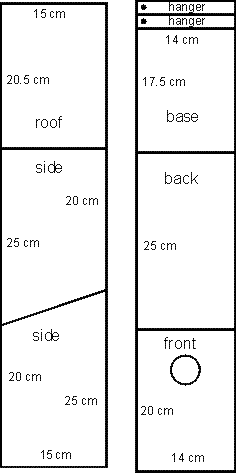Building a bird box
Nest boxes in gardens are often occupied by blue tits or great tits
Try to get your nest boxes in position as early as possible, preferably at the beginning of January. Our blue tits started making exploratory visits in mid February. Each year on St. Valentine's Day - 14th February - the British Trust for Ornithology (BTO) launches its National Nest Box Week, with the aim of encouraging people to put up nest boxes to help breeding birds and other wildlife.
The plan layout for a typical nest box is shown below. Many decorative bird boxes are totally unsuitable for parent birds and their families. Bird boxes designed as an integral part of a bird table are unlikely to be occupied. It would be like living above a fast food take-away! Choose a quiet and undisturbed part of your garden for the completed box.
Please check that any plywood you use for your bird boxes comes from FSC (Forest Stewardship Council) sources. FSC certified tropical hardwood plywood ensures that the use of the material will not damage forests, harm wildlife or jeopardise the future of people whose lives depend on the forests. An easiliy available source would be B&Q as B&Q (UK) now only buys Forest Stewardship Council timber and the FSC label will be on the timber product.
 The bird box dimensions hown here are very similar
to those recommended by the RSPB. These nest boxes are suitable for
small birds such as blue tit / great tit.
The bird box dimensions hown here are very similar
to those recommended by the RSPB. These nest boxes are suitable for
small birds such as blue tit / great tit.
My bird boxes were made using 12mm exterior ply wood. The roof dimensions allow for an overhang at the sides and front to let water drain away and to keep the interior dry.
Make sure that the entrance hole is at least 12.5 cm from the floor of the box to keep the young chicks safe from predators. A hole diameter of 25 mm will allow blue tits, coal tits and marsh tits to enter the box. Use 28 mm for great tits and 32 mm for house sparrows, tree sparrows and nuthatches.
I used brass screws to fasten everything together and also screwed on the roof to allow access to the nest box camera and to enable the nest to be removed at the end of the season, in either October or November.
Water based preservatives may be used on the outside of the box only. Keep any preservative away from the entrance hole, as birds often tap this regularly with their beak before deciding whether to occupy.
Drill a couple of small holes in the base to keep the nest dry.
Hang the box at least two metres off the ground, preferably between north and east to avoid strong sunlight. If fixing the nestbox to a tree it's preferable to use thick wire on the hangers rather than fixing with nails. If you find the birds pecking at the entrance hole, it does not mean that the hole is too small. The RSPB suggest that the pecking may be a form of display by the male, and that the females peck at the hole to test the strength of the wood to determine if the box will make a secure home.
Do not inspect the nest box when in use, as the parents may desert the eggs or chicks.

